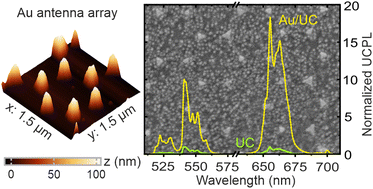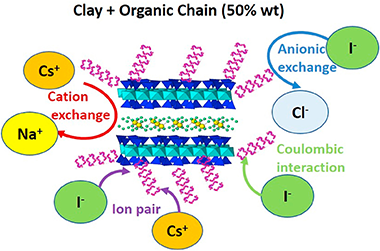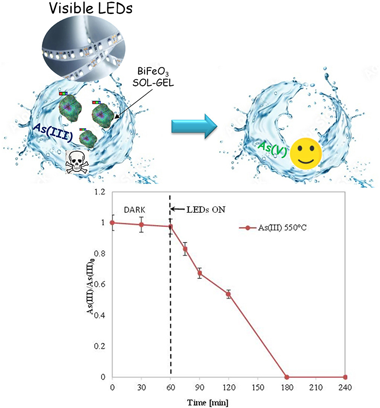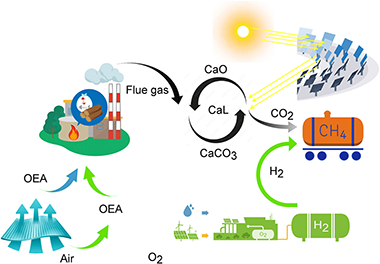Scientific Papers in SCI
2023
2023
Materiales Ópticos Multifuncionales
Enhancement of upconversion photoluminescence in phosphor nanoparticle thin films using metallic nanoantennas fabricated by colloidal lithography
Ngo, TT; Viaña, JM; Romero, M; Calvo, ME; Lozano, G; Miguez, HMaterials Advances, 4 (2023) 6381-6388
Show abstract ▽

Lanthanide-doped upconversion nanoparticles (UCNPs), as multifunctional light sources, are finding utility in diverse applications ranging from biotechnology to light harvesting. However, the main challenge in realizing their full potential lies in achieving bright and efficient photon upconversion (UC). In this study, we present a novel approach to fabricate an array of gold nanoantennas arranged in a hexagonal lattice using a simple and inexpensive colloidal lithography technique, and demonstrate a significant enhancement of UC photoluminescence (UCPL) by up to 35-fold through plasmon-enhanced photoexcitation and emission. To elucidate the underlying physical mechanisms responsible for the observed UCPL enhancement, we provide a comprehensive theoretical and experimental characterization, including a detailed photophysical description and numerical simulations of the spatial electric field distribution. Our results shed light on the fundamental principles governing the enhanced UCNPs and pave the way for their potential applications in photonic devices.
November, 2023 | DOI: 10.1039/D3MA00775H
Materiales de Diseño para la Energía y Medioambiente
A technological approach based on engineered nanoclay composites for cesium and iodine retention
Osuna, FJ; Pavon, E; Alba, MDChesmosphere, 341 (2023) 140128
Show abstract ▽

The development of effective and environmentally friendly methods for separating hazardous radionuclides from waste poses a significant technological challenge. 137Cs and 131I are among the most important radionuclides discharged into the environment by nuclear power plants. One of the best ways to eliminate them involves adsorption on clay minerals. In this regard, studies have demonstrated that organofunctionalized clay minerals are effective adsorbents. Thus, this study investigates the capability of organofunctionalized synthetic design clay minerals to jointly eliminate cesium and iodine. The adsorbents studied are a range of organofunctionalized clay minerals with alkylammonium cations of different alkyl chain lengths (2, 3 and 18) and some physical mixtures of raw clay minerals and octadecylammonium compounds. Organofunctionalized synthetic swelling highly charged micas are effective adsorbents for the simultaneous adsorption of cesium and iodine. In addition, the optimal system is a mixture of Na-M4 with octadecylammonium (50% w/w).
November, 2023 | DOI: 10.1016/j.chemosphere.2023.140128
Fotocatálisis Heterogénea: Aplicaciones
Bismuth ferrite as innovative and efficient photocatalyst for the oxidation of As(III) to As(V) under visible light
Chianese, L; Murcia, JJ; Hidalgo, MC; Vaiano, V; Iervolino, GMaterials Science in Semiconductor Processing, 167 (2023) 107801
Show abstract ▽

The presence of As in drinking water is a problem felt all over the world. In particular, arsenic is present in +3 (As(III)) and +5 (As(V)) oxidation states. However, As(III) is the most toxic and difficult to remove with conventional adsorption processes. A pre-oxidation process is therefore necessary. In this work, we report, for the first time, the use of BiFeO3 as a visible-light active photocatalyst for the complete and fast oxidation of As(III) to As(V) in water. In particular, the influence of annealing temperature for BiFeO3 preparation was studied and the prepared photocatalysts were characterized through XRD, N2 adsorption at −196°C, TEM, XPS, Raman and UV–Vis DRS spectroscopy. The best photocatalytic activity was achieved with BiFeO3 calcined at 550°C. The influence of catalyst dosage and the role of the main oxidizing species was evaluated, evidencing the key role of h+ in the photooxidation reaction of As(III) to As(V). Moreover, the efficiency of the photocatalyst was also evaluated in the case of drinking water contaminated by arsenic. The results demonstrated that, despite the presence of dissolved salts in the drinking water, the photocatalyst maintained its activity. The results obtained in this work prove that BiFeO3 calcined at 550°C evidenced photocatalytic performances better than different photocatalyst formulations studied for the photooxidation of As(III) to As(V) under visible light.
November, 2023 | DOI: 10.1016/j.mssp.2023.107801
Reactividad de Sólidos
Negative emissions power plant based on flexible calcium-looping process integrated with renewables and methane production
Ortiz, C; García-Luna, S; Carro, A; Chacartegui, R; Pérez-Maqueda, LRenewable & Sustainable Energy Reviews, 185 (2023) 113614
Show abstract ▽

This paper provides a review of negative carbon capture technologies. Based on these technologies, here it is proposed an innovative negative emissions power plant combining the generation and storage of energy from biomass, photovoltaic, and concentrated solar power, capturing and recovering CO2 by producing H2 or CH4 as green energy carriers. The main features of the system are i) large-scale energy production system with negative CO2 emissions; ii) 100% renewable system based on biomass and solar energy with the possibility of integrating other renewables; iii) synergistic integration of processes and systems; iv) recovery of O2 generated by photovoltaic-driven electrolysis within the process of partial biomass oxycombustion and v) solar-driven limestone calcination. A detailed model of the entire plant is developed to evaluate the integration of the process. The model performance is assessed on an hourly basis throughout the whole year. The base case results show an energy consumption from 1 to 2.1 MJ/kg CO2 to capture 60–77% of CO2 emitted from the biomass plant and green methane production of more than 7500 tons/year. The negative emissions associated with the process are -612 kg CO2/MWh. It justifies the interest in the proposed negative emissions power plant.
October, 2023 | DOI: 10.1016/j.rser.2023.113614
Química de Superficies y Catálisis
Low-temperature reverse water gas-shift reaction over highly efficient Cu-hydrotalcites: Mechanistic insights on the role of malachite phase
Alvarez-Hernandez, D; Marin-Sanchez, M; Lobo-Andrades, L; Azancot, L; Bobadilla, LF; Ivanova, S; Centeno, MACatalysis Today, 422 (2023) 114235
Show abstract ▽
Carbon dioxide (CO2) transformation into valuable fuels and chemicals is in most cases a challenge far from readiness nowadays. One possible route for its conversion is the reverse water gas shift reaction (rWGS), crucial for syngas generation and required for the chemical conversion of CO2 to fuels and platform chemicals. In this paper, well organized Cu/Zn/Al structures were proposed as efficient catalysts for rWGS reaction at low tem-peratures. The results of in situ XRD revealed the formation of layered structures such malachite and hydro-talcite. The operando DRIFTS-MS studies of those structure suggests a participation of Cu2+/Cu+ pair in the reaction, promoting the redox mechanism and enhancing the activity at lower temperature. This work also provides a new strategy to design Cu-based rWGS catalysts able to prevent the sintering of active phase.
October, 2023 | DOI: 10.1016/j.cattod.2023.114235
- ‹ previous
- 11 of 412
- next ›














